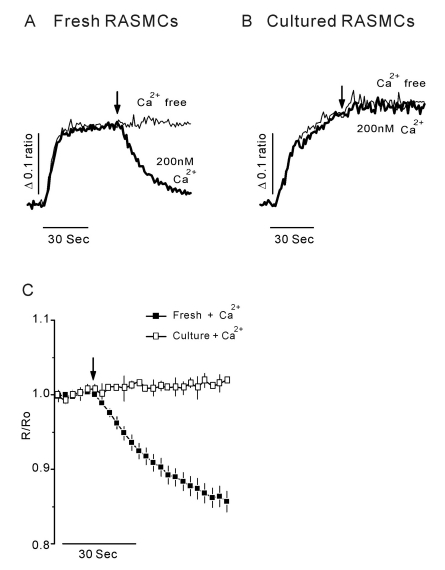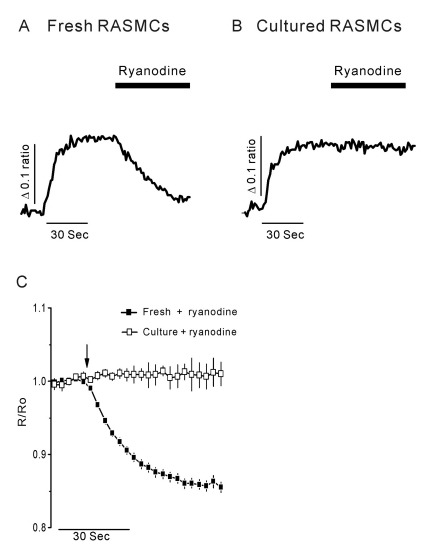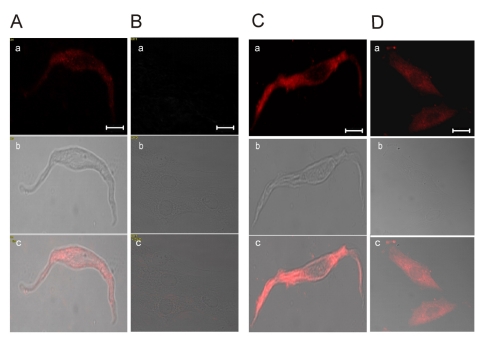1. Chamley-Campbell J, Campbell GR, Ross R. The smooth muscle cell in culture. Physiol Rev. 1979; 59:1–61. PMID:
108688.

2. Schwartz SM, Campbell GR, Campbell JH. Replication of smooth muscle cells in vascular disease. Circ Res. 1986; 58:427–444. PMID:
3516443.

3. Halayko AJ, Salari H, MA X, Stephens NL. Markers of airway smooth muscle cell phenotype. Am J Physiol. 1996; 270:L1040–L1051. PMID:
8764231.

4. Thyberg J. Differentiated properties and proliferation of arterial smooth muscle cells in culture. Int Rev Cytol. 1996; 169:183–265. PMID:
8843655.

5. Berridge MJ. Inositol trisphosphate and calcium signalling. Nature. 1993; 361:315–325. PMID:
8381210.

6. Ghosh TK, Bian JH, Short AD, Rybak SL, Gill DL. Persistent intracellular calcium pool depletion by thapsigargin and its influence on cell growth. J Biol Chem. 1991; 266:24690–24697. PMID:
1761564.

7. Short AD, Bian J, Ghosh TK, Waldron RT, Rybak SL, Gill DL. Intracellular Ca
2+ pool content is linked to control of cell growth. Proc Natl Acad Sci USA. 1993; 90:4986–4990. PMID:
8389460.
8. Waldron RT, Short AD, Meadows JJ, Ghosh TK, Gill DL. Endoplasmic reticulum calcium pump expression and control of cell growth. J Biol Chem. 1994; 269:11927–11933. PMID:
8163492.

9. Wang Y, Chen J, Wang Y, Taylor CW, Hirata Y, Hagiwara H, Mikoshiba K, Toyo-oka T, Omata M, Sakaki Y. Crucial role of type 1, but not type 3, inositol 1,4,5-trisphosphate (IP
3) receptors in IP
3-induced Ca
2+ release, capacitative Ca
2+ entry, and proliferation of A7r5 vascular smooth muscle cells. Circ Res. 2001; 88:202–209. PMID:
11157673.
10. Savineau JP. Is the translocon a crucial player of the calcium homeostasis in vascular smooth muscle cell? Am J Physiol Heart Circ Physiol. 2009; 296:H906–H907. PMID:
19252099.

11. Hirota S, Helli P, Janssen LJ. Ionic mechanisms and Ca
2+ handling in airway smooth muscle. Eur Respir J. 2007; 30:114–133. PMID:
17601970.
12. Côrtes SF, Lemos VS, Stoclet JC. Alterations in calcium stores in aortic myocytes from spontaneously hypertensive rats. Hypertension. 1997; 29:1322–1328. PMID:
9180636.

13. Côrtes SF, Lemos VS, Corriu C, Stoclet JC. Changes in angiotensin II receptor density and calcium handling during proliferation in SHR aortic myocytes. Am J Physiol. 1996; 271:H2330–H2338. PMID:
8997290.
14. Choi KJ, Kim KS, Kim SH, Kim DK, Park HS. Caffeine and 2-aminoethoxydiphenyl borate (2-APB) have different ability to inhibit intracellular calcium mobilization in pancreatic acinar cell. Korean J Physiol Pharmacol. 2010; 14:105–111. PMID:
20473382.

15. Hume JR, McAllister CE, Wilson SM. Caffeine inhibits InsP
3 responses and capacitative calcium entry in canine pulmonary arterial smooth muscle cells. Vascul Pharmacol. 2009; 50:89–97. PMID:
19084078.
16. Islam MS. The ryanodine receptor calcium channel of beta-cells: molecular regulation and physiological significance. Diabetes. 2002; 51:1299–1309. PMID:
11978625.
17. Kamishima T, Quayle JM. Ca
2+-induced Ca
2+ release in cardiac and smooth muscle cells. Biochem Soc Trans. 2003; 31:943–946. PMID:
14505454.
18. Choi KJ, Cho DS, Kim JY, Kim BJ, Lee KM, Kim SH, Kim DK, Kim SH, Park HS. Ca
2+-induced Ca
2+ release from internal stores in INS-1 rat insulinoma cells. Korean J Physiol Pharmacol. 2011; 15:53–59. PMID:
21461241.
19. Masumiya H, Li P, Zhang L, Chen SR. Ryanodine sensitizes the Ca
2+ release channel (ryanodine receptor) to CaCa
2+ activation. J Biol Chem. 2001; 276:39727–39735. PMID:
11507100.
20. Vallot O, Combettes L, Jourdon P, Inamo J, Marty I, Claret M, Lompré AM. Intracellular Ca
2+ handling in vascular smooth muscle cells is affected by proliferation. Arterioscler Thromb Vasc Biol. 2000; 20:1225–1235. PMID:
10807737.
21. Berra-Romani R, Mazzocco-Spezzia A, Pulina MV, Golovina VA. Ca
2+ handling is altered when arterial myocytes progress from a contractile to a proliferative phenotype in culture. Am J Physiol Cell Physiol. 2008; 295:C779–C790. PMID:
18596214.
22. Perez CF, Voss A, Pessah IN, Allen PD. RyR1/RyR3 chimeras reveal that multiple domains of RyR1 are involved in skeletal-type E-C coupling. Biophys J. 2003; 84:2655–2663. PMID:
12668474.

23. Copello JA, Barg S, Sonnleitner A, Porta M, Diaz-Sylvester P, Fill M, Schindler H, Fleischer S. Differential activation by Ca
2+, ATP and caffeine of cardiac and skeletal muscle ryanodine receptors after block by Mg
2+. J Membr Biol. 2002; 187:51–64. PMID:
12029377.
24. Fessenden JD, Wang Y, Moore RA, Chen SR, Allen PD, Pessah IN. Divergent functional properties of ryanodine receptor types 1 and 3 expressed in a myogenic cell line. Biophys J. 2000; 79:2509–2525. PMID:
11053126.

25. Nakai J, Ogura T, Protasi F, Franzini-Armstrong C, Allen PD, Beam KG. Functional nonequality of the cardiac and skeletal ryanodine receptors. Proc Natl Acad Sci USA. 1997; 94:1019–1022. PMID:
9023375.

26. Nelson MT, Cheng H, Rubart M, Santana LF, Bonev AD, Knot HJ, Lederer WJ. Relaxation of arterial smooth muscle by calcium sparks. Science. 1995; 270:633–637. PMID:
7570021.

27. Dreja K, Nordström I, Hellstrand P. Rat arterial smooth muscle devoid of ryanodine receptor function: effects on cellular Ca
2+ handling. Br J Pharmacol. 2001; 132:1957–1966. PMID:
11309269.
28. Arnould T, Vankoningsloo S, Renard P, Houbion A, Ninane N, Demazy C, Remacle J, Raes M. CREB activation induced by mitochondrial dysfunction is a new signaling pathway that impairs cell proliferation. EMBO J. 2002; 21:53–63. PMID:
11782425.

29. Giebler HA, Lemasson I, Nyborg JK. p53 recruitment of CREB binding protein mediated through phosphorylated CREB: a novel pathway of tumor suppressor regulation. Mol Cell Biol. 2000; 20:4849–4858. PMID:
10848610.

30. Wilkerson MK, Heppner TJ, Bonev AD, Nelson MT. Inositol trisphosphate receptor calcium release is required for cerebral artery smooth muscle cell proliferation. Am J Physiol Heart Circ Physiol. 2006; 290:H240–H247. PMID:
16113072.

31. Kusner LL, Mygland A, Kaminski HJ. Ryanodine receptor gene expression thymomas. Muscle Nerve. 1998; 21:1299–1303. PMID:
9736058.

32. Jaggar JH, Nelson MT. Differential regulation of Ca
2+ sparks and Ca
2+ waves by UTP in rat cerebral artery smooth muscle cells. Am J Physiol Cell Physiol. 2000; 279:C1528–C1539. PMID:
11029300.
33. Gomez MF, Stevenson AS, Bonev AD, Hill-Eubanks DC, Nelson MT. Opposing actions of inositol 1,4,5-trisphosphate and ryanodine receptors on nuclear factor of activated T-cells regulation in smooth muscle. J Biol Chem. 2002; 277:37756–37764. PMID:
12145283.









 PDF
PDF ePub
ePub Citation
Citation Print
Print


 XML Download
XML Download